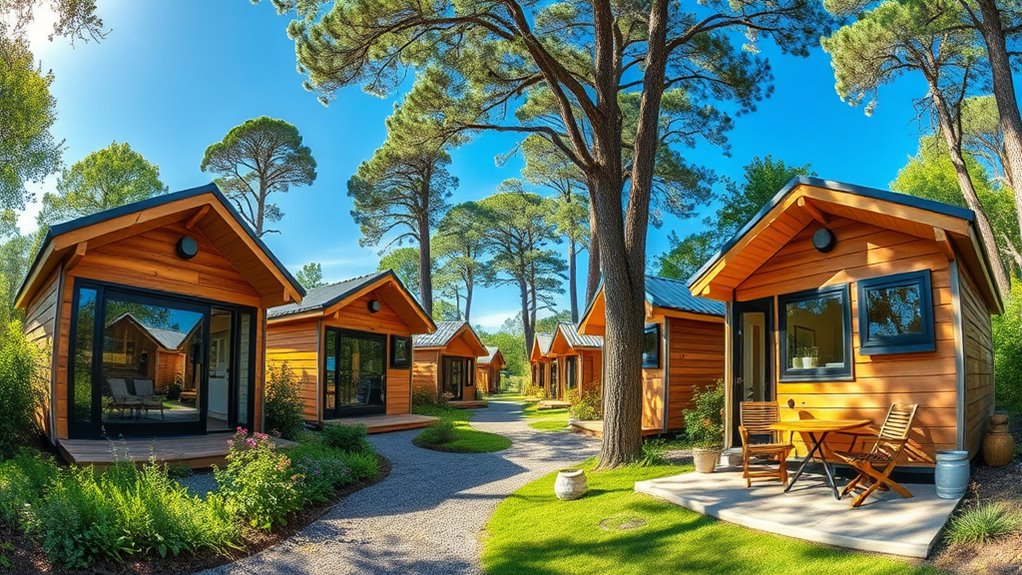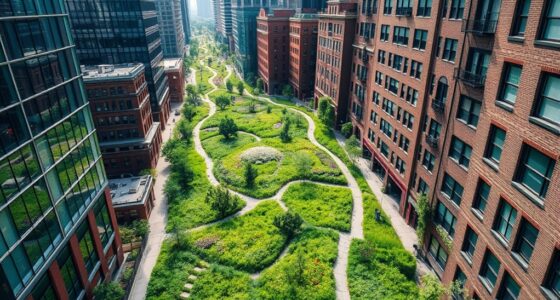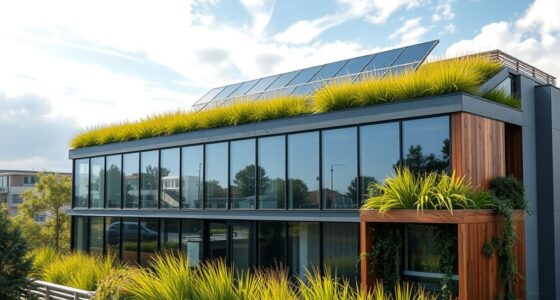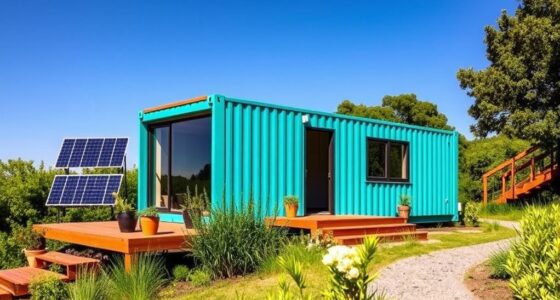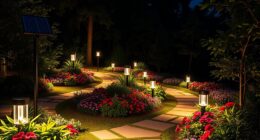Living large with a small footprint in an off-grid tiny house means embracing sustainable design, renewable energy, and minimalist living. You can enjoy independence by installing solar panels and eco-friendly features like rainwater harvesting and efficient appliances. This lifestyle allows you to settle in remote, scenic locations while reducing your environmental impact. With thoughtful design and self-sufficiency, you’ll experience freedom and simplicity. Keep exploring to discover how these tiny homes can transform your life and deepen your connection to nature.
Key Takeaways
- Off-grid tiny houses maximize independence using renewable energy sources like solar panels and wind turbines.
- They promote a minimalist lifestyle, reducing clutter and emphasizing essential possessions for a simpler life.
- Sustainable design features, such as eco-friendly materials and high insulation, lower environmental impact and living costs.
- These homes can be placed in remote, scenic locations, fostering a stronger connection to nature.
- Combining resilience and adaptability, they ensure continuous power and comfort in various climates and seasons.
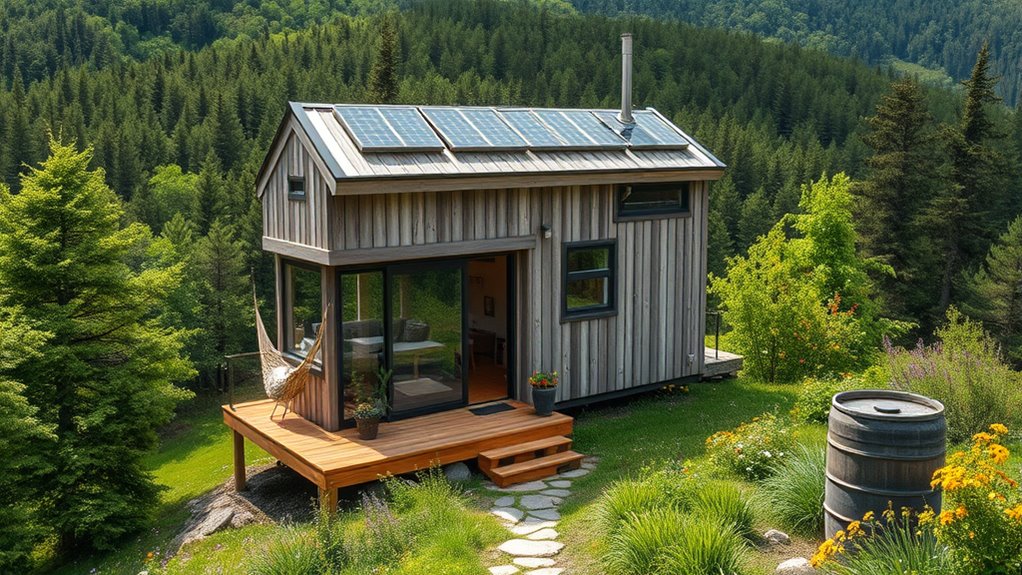
Off-grid tiny houses offer a sustainable and flexible way to live independently away from traditional utility systems. When you choose this lifestyle, you’re embracing a smaller footprint while maintaining all the comforts of home. Central to this independence is the integration of solar power, which allows you to generate your own electricity without relying on the grid. Solar panels can be installed on your tiny house’s roof, capturing sunlight during the day and converting it into energy that powers your appliances, lighting, and electronics. With advancements in solar technology, you’ll find options that are more efficient, affordable, and easy to install, making off-grid living more accessible than ever.
Embrace off-grid living with solar-powered tiny houses that combine sustainability, independence, and modern convenience.
A key element of this lifestyle is sustainable design. Your tiny house is built with eco-friendly materials and thoughtful layouts that maximize space and energy efficiency. Features like high-quality insulation reduce the need for excessive heating or cooling, while energy-efficient appliances minimize power consumption. These design choices not only lessen your environmental impact but also lower your living costs over time. You might incorporate rainwater harvesting systems or composting toilets to further reduce reliance on external utilities, turning your tiny house into a self-sufficient haven.
Living off-grid isn’t just about reducing your carbon footprint; it’s about creating a resilient and adaptable living environment. You can customize your tiny house with renewable energy sources like solar power, wind turbines, or micro-hydropower systems if you’re near water. The goal is to produce as much energy as you consume, ensuring you stay powered even during cloudy days or seasons with less sunlight. Many tiny house designs feature large windows and open layouts to maximize natural light and ventilation, decreasing dependence on artificial lighting and climate control systems.
This approach to living also encourages a minimalist mindset. Because space is limited, you’re motivated to prioritize only essential possessions, which simplifies your life and reduces clutter. With fewer belongings and lower utility needs, your overall carbon footprint diminishes further. The flexibility of off-grid tiny houses means you can place them in remote, scenic locations, creating a peaceful retreat that’s entirely your own. As you live more sustainably, you’ll find that your connection to the environment deepens, and your reliance on external energy sources lessens each day.
In essence, choosing an off-grid tiny house built with sustainable design and solar power not only benefits the planet but also grants you a sense of freedom and independence. You’ll enjoy the simplicity of small-scale living while making a positive impact on the environment, proving that living large can start with a small footprint. Additionally, understanding the spiritual symbolism of renewable energy and sustainable living can enhance your connection to the natural world and deepen your commitment to eco-conscious choices.
Frequently Asked Questions
How Do Off-Grid Tiny Houses Handle Sewage and Waste Management?
You handle sewage and waste management in off-grid tiny houses by using composting toilets or small septic systems. These options manage waste disposal effectively without relying on municipal systems. Composting toilets convert waste into compost, while septic systems treat sewage on-site. Regular maintenance and proper waste disposal practices guarantee your tiny house remains eco-friendly and odor-free, making off-grid living sustainable and convenient.
What Are the Initial Costs of Building an Off-Grid Tiny House?
Imagine stepping into your cozy tiny house, feeling the warmth of your investment. The initial costs vary, with a cost breakdown covering land, foundation, building materials, and utilities. You might spend $10,000 to $50,000 depending on size and finishes. Financing options like personal loans or savings help, making it more manageable. You create a sustainable home that fits your budget and lifestyle, turning a dream into reality.
How Do Off-Grid Tiny Houses Perform in Extreme Weather Conditions?
You might wonder how off-grid tiny houses handle extreme weather. With proper insulation challenges addressed, they can stay warm or cool efficiently. You’ll need reliable heating solutions like wood stoves or solar-powered systems to maintain comfort in winter, and ventilation or shading for hot summers. When built with weather-resistant materials and thoughtful design, these tiny homes perform well, offering resilience and comfort despite harsh conditions.
What Legal Restrictions Exist for Off-Grid Tiny Houses?
Oh, the joys of tiny house freedom—until zoning laws and building codes remind you who’s boss. You’ll find restrictions on where you can park, how tall you can build, and even if you can live off-grid at all. Local governments love to keep tiny houses small in legality, making it a challenge to navigate zoning laws and building codes. So, enjoy your minimalist lifestyle—just don’t forget to check the rules first.
How Sustainable Are Off-Grid Tiny Houses Over the Long Term?
You’ll find that off-grid tiny houses are quite sustainable long-term if you focus on solar efficiency and water sourcing. By maximizing solar panel output, you make certain reliable power, while well-planned rainwater collection and filtration keep your water supply steady. Regular maintenance and eco-friendly practices help reduce your environmental impact, making your tiny house a sustainable, self-sufficient living option that minimizes waste and energy use over time.
Conclusion
Living off-grid in a tiny house isn’t just about saving space; it’s about embracing simplicity and independence. You might find that the smallest footprints hold the biggest surprises, like discovering how little you need to feel truly free. Sometimes, the universe aligns perfectly—an unexpected sunrise or a quiet moment—reminding you that living large can happen in the smallest places. It’s a journey where coincidence becomes a gentle nudge toward a more intentional, fulfilling life.
